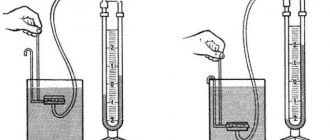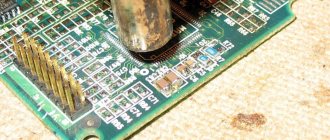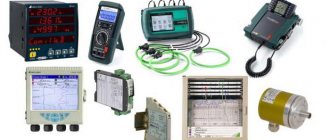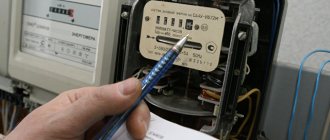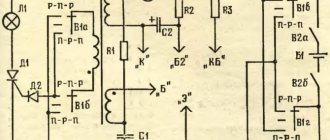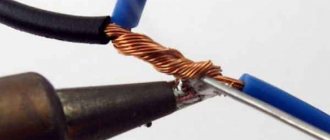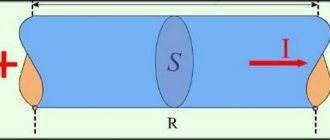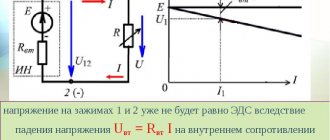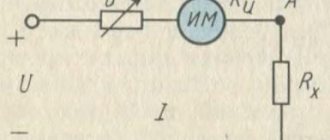Resistance meter
Answer for the question "Resistance meter", 6 (six) letters: ohmmeter
Alternative crossword questions for the word ohmmeter
Definition of the word ohmmeter in dictionaries
Encyclopedic Dictionary, 1998. The meaning of the word in the dictionary Encyclopedic Dictionary, 1998. OHMETER (from ohm and meter) a device for directly measuring electrical active (ohmic) resistance; types of ohmmeter - megohmmeters, teraohmmeters, etc.
Great Soviet Encyclopedia The meaning of the word in the dictionary Great Soviet Encyclopedia (from ohm and meter), a direct reading device for measuring electrical active (ohmic) resistance. Types of O.: megohmmeters, teraohmmeters, microohmmeters, differing in the range of measured resistances. O. is made with magnetoelectric.
Examples of the use of the word ohmmeter in literature.
Chuckling softly, he connected the power supply to one part of the lizard inverter and the ohmmeter to the other.
His gaze read the readings of all instruments at once: speedometer, ohmmeter, tachometer.
I went to a deserted island, where I went through and tested hundreds of electric detonators with an ohmmeter in my hands, selecting detonators with the required resistance.
The room was as he had left it: a workbench, soldering irons, ohmmeters, voltmeters, lamp testers, rolls of wire, boxes of spare parts, a broken umbrella that he was going to fix.
He saw the control panels for the power plant, the fuel supply, rows of voltmeters, ohmmeters, tachometers, levers, cranes, wheels on cranks and felt that his head was spinning.
Source: Maxim Moshkov library
Source
What is wire insulation resistance
Insulation resistance is one of the most important parameters of any cables and conductors. This is based on the fact that all wires are subject to external influences during their operation. In addition to external influence, there are also internal ones: the influence of the cores of one wire on each other, interaction through electromagnetic fields. All this, one way or another, leads to leaks.
Industrial megger for measuring large resistance values
That is why any electrical and non-electrical wires are created with insulation that protects the conductor from external influences. Popular insulating materials include rubber, polyvinyl chloride, oil, wood and paper. These materials are used based on the purpose of the cable. For example, wires buried underground are insulated with relatively thick dielectric tape, while telecommunications cables may be enclosed in a simple aluminum foil wrapper.
Old Soviet analog bench ohmmeter
Important! Insulation is the protection of cores from exposure to otherworldly factors, protection of cores from each other, from short circuits and from various leaks. Insulation resistance is the amount of resistance between the conductors of a wire or between one of the conductors and the insulating layer.
Any material ages and deteriorates over time, which leads to deterioration of its characteristics and a decrease in insulation resistance to direct or alternating current. The insulation resistance characteristic is indicated on the cable and is standardized in its GOST. It is determined in laboratory conditions at a temperature of 20 degrees.
Carrying out resistance measurements with a professional megohmmeter
Low-frequency communication cables have a minimum insulation resistance of 5 Gigaohms per kilometer, and coaxial cables, in turn, have a minimum insulation resistance of 10 Gigaohms per kilometer. Measurement and testing of resistance is carried out on a regular basis with a megohmmeter: at mobile communication installations - once every 6 months, at high-risk facilities - once every 12 months, at other facilities - once every three years.
You might be interested in Checking capacitor capacity with testers
Resistor to increase the resistance of the electrical network
Measures resistance
Answer for the question "Measures resistance", 6 (six) letters: ohmmeter
Alternative crossword questions for the word ohmmeter
Definition of the word ohmmeter in dictionaries
Great Soviet Encyclopedia The meaning of the word in the dictionary Great Soviet Encyclopedia (from ohm and meter), a direct reading device for measuring electrical active (ohmic) resistance. Types of O.: megohmmeters, teraohmmeters, microohmmeters, differing in the range of measured resistances. O. is made with magnetoelectric.
What is a multimeter
A multimeter or multitester is a compact, ergonomic and multifunctional device for measuring the basic parameters of an electrical network for any purpose. All multimeters allow you to measure current, voltage, resistance and even temperature with a certain accuracy using their probes.
Appearance of a typical dielectric plastic digital multimeter
There are two types of multimeters:
- Analogue, which display measurement results using mechanical display tools: arrows, bars and division values, showing the quantitative characteristics of the measured value;
- Digital. The most commonly used types of devices, the information is displayed through a built-in display, and all data is calculated digitally.
You may be interested in Measuring with a multimeter with current clamps
Megaohmmeter GM3123 for use in industrial high voltage networks
Screwdriver for checking voltage: what is it called and what does it work
A tool that allows you to measure the mains voltage is called an indicator screwdriver. The device has a wide range of applications and is easy to use. Therefore, it is used by both ordinary people and professional electricians.
An indicator screwdriver is most often used in the following cases:
- To determine the neutral wire or phase.
- To find out the polarity of batteries and other power supplies.
- To detect wiring hidden in the wall.
- To find the location of a break in the power supply.
- To check the performance of diodes, incandescent lamps, various radio components, devices equipped with heating elements.
Reference. Modern models are equipped with a liquid crystal display. Therefore, they have an additional function - they allow you not only to check the voltage in the network, but also to measure its value, as well as find out the location of the positive and negative electrodes.
The operating principle of the device is as follows:
- When the tip of the screwdriver comes into contact with the phase or positively charged terminal of the battery, voltage begins to flow through it.
- Through the rod, current flows to a miniature resistor with an impedance of 1 ohm. In this case, the device independently reduces the voltage to a value that is safe for the device and humans.
- Next, an electric current flows to the neon lamp, which causes the gas inside the element to glow.
- After this, the remaining tension passes through the human body and goes into the ground.
How is it designated?
As has already become clear, measuring resistance with a multimeter is not difficult and it should not cause any problems. The parameter is measured in Ohms in honor of the German physicist who was the first to confirm the relationship between current, voltage and resistance. On multimeters and testers, this value is designated by the Greek letter “omega” - Ω.
The desired quantity is depicted on instruments with the Greek letter “omega”
Types of indicator screwdrivers
There are several options for the measuring device. They differ in design, operating principle, and additional functions. So, on sale are: simple tools, models with a built-in battery, electronic, non-contact.
A simple model with a neon light bulb
The design of the most common and accessible model consists of the following elements:
- Housing made of durable transparent plastic. It is often painted in bright colors.
- Flat tip rod.
- Resistor. The element voltage must be at least 1 ohm.
- Small neon lamp.
- Contact surface.
To make the product convenient to transport, there is a plastic clip in its upper part.
Despite its simplicity, low cost and ease of use, the device has limited capabilities. It will not be possible to measure voltage if its value is less than 60 V.
Non-contact battery-powered measuring device
Despite the external similarity with the previous version, it has a different design. For example, instead of a neon lamp, a miniature LED is used here. This significantly expands the functionality, allowing measurements to be carried out on networks with voltages less than 60 V.
The device allows you to check circuits of radio and electrical equipment, determine the functionality of fuses, and find broken wires. A bipolar transistor and an autonomous battery allow for contactless manipulation.
Measuring screwdriver with contact batteries
It is a kind of hybrid of a conventional and contactless model. This also uses an LED and a resistor. The main difference is the presence of a contact surface. This eliminates the possibility of contactless network checking.
Electronic options
Its design consists of elements:
- small rod;
- housings made of dense opaque plastic;
- miniature LCD display;
- two contact surfaces.
This is a modern, universal device. Compared to the previous ones, the electronic model has broader functions: with its help you can “ring” the electrical network for a short circuit, make contact or non-contact measurements.
How to use a screwdriver to test voltage
Despite the similar design and ease of use, each device has its own nuances of use.
Simple screwdriver
To determine the presence or absence of electric current in an outlet or on a section of the electrical network, carry out the following manipulations:
- Place the tip of the tip on the contact of the socket or the section of the network being studied.
- Use your finger to press on the special pole plane, which is located at the end.
If the device is working properly, there is voltage in the circuit, the screwdriver will indicate this by glowing a neon light bulb.
Self-powered and LED element
To determine the neutral or phase contact, you just need to touch the socket or section of the electrical circuit with the rod. If the device is working properly, there is no open circuit, the LED will light up brightly. You don't need to put your finger on it.
With LCD display
Allows inspection by both contact and non-contact methods. In the first case, the process is the same as when using a simple screwdriver. However, in this case, the device will notify you with an inscription on the indicator.
In the non-contact method, the device is brought as close as possible to the object being examined. Then press the button on the case. If the device is working properly and the network section is energized, a lightning bolt symbol will be displayed on the LCD display.
A modern tool allows you to quickly find damaged sections of an electrical circuit and repair various devices. It is important to remember to follow safety precautions. Experts do not recommend using non-working or faulty devices - this can lead to electric shock or incorrect test results.
Source
